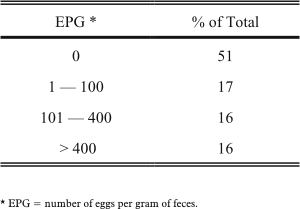The present survey from the State of Alagoas (Brazil) emphasized, once again, the importance of peridomestic or neighbourhood foci in the transmission of schistosomiasis mansoni. Although the study area consisted of a compact and densely populated urban community (Bairro Frio, União dos Palmares county), prevalence as well as the distribution of high egg counts was quite patchy, exhibiting a spatial pattern correlated with the distribution of ditches and other small-sized collections of surface water. Despite the availability of satisfactory water supply in most households, as well as the absence of any major body of water capable of furthering transmission, egg counts in Bairro Frio exceeded any other in our previous experience. Morbidity, however, appeared to be insignificant, a trend which has been observed over the last decade in several other highly endemic areas. It appears clear to the authors that the control of transmission requires investment in environmental intervention and that this proposal, far from being utopic, can be furthered by quite modest means and through the participation of community or neighbourhood groups.
Schistosomiasis; Schistosoma mansoni; Control; Community Participation





